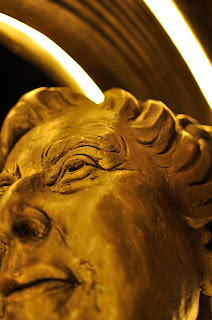I then photographed the CD with my table spotlight shining next to the CD - I like the effect the light has had on the colour on the left-hand side:
I then tried making a cone, as per the instructions. This wasn't enormously successful - the paper and lens reflected into the CD:
I then tried photographing the CD with the paper over the lamp instead:
Finally, I tried photographing the CD at an angle to reduce reflection, first with no additional light and then with the diffused lamp - again, not too succesful as the CD caught the window reflection instead - although I like the colour streak in the bottom picture:
I then experimented a bit with another shiny surface and different kinds of lighting, involving my pink geode, a candle and a table spotlamp:
And then with the ring resting on the CD, with the light shinning directly on it:
I then brought in all the combinations of light, CD, geode, trying to create reflections off the silver ring:
This was however, all playtime, so I then went back to the orginal instructions and photographed the ring inside the cone with the light shinning through the paper:
























































































































